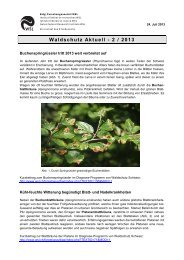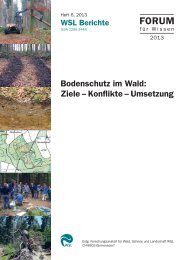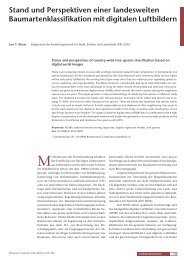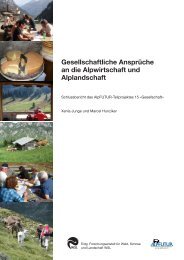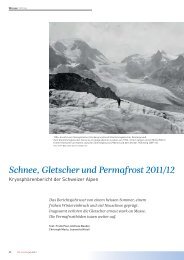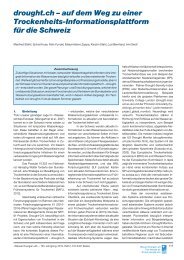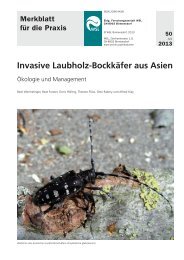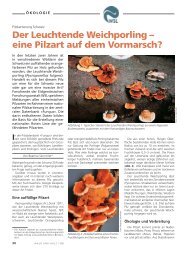Ecology and management of the spruce bark beetle Ips ... - WSL
Ecology and management of the spruce bark beetle Ips ... - WSL
Ecology and management of the spruce bark beetle Ips ... - WSL
Create successful ePaper yourself
Turn your PDF publications into a flip-book with our unique Google optimized e-Paper software.
74<br />
8.3. What causes <strong>the</strong> tree to die?<br />
The dieback <strong>of</strong> an infested tree is not only <strong>the</strong> result<br />
<strong>of</strong> I. typographus feeding but also <strong>of</strong> <strong>beetle</strong>-associated<br />
blue-stain fungi such as <strong>the</strong> Ophiostoma <strong>and</strong> Ceratocystis<br />
species (Paine et al., 1997; Lieutier, 2002). They<br />
are mainly vectored on <strong>the</strong> <strong>beetle</strong>’s pronotum <strong>and</strong><br />
elytra (Furniss et al., 1990). A number <strong>of</strong> fungal<br />
species have been found to be associated with I.<br />
typographus (e.g. Furniss et al., 1990; Solheim,<br />
1993; Krokene <strong>and</strong> Solheim, 1996; Kirschner,<br />
1998). Among different <strong>bark</strong> <strong>beetle</strong> species, I. typographus<br />
was found to carry more pathogenic fungi<br />
than o<strong>the</strong>r species (Krokene <strong>and</strong> Solheim, 1996).<br />
Attacked trees die faster than would be expected by<br />
solely phloem girdling due to larval feeding. The fungi<br />
may dry <strong>the</strong> tissue <strong>and</strong> induce tracheid aspiration or<br />
vascular plugging (Paine et al., 1997).<br />
Recently, <strong>the</strong> mechanisms <strong>of</strong> conifer resistance, <strong>the</strong><br />
corresponding colonization strategies <strong>of</strong> different <strong>bark</strong><br />
<strong>beetle</strong> species, <strong>and</strong> <strong>the</strong> process <strong>of</strong> tree death have been<br />
extensively summarized by Lieutier (2002).<br />
9. Dynamics <strong>of</strong> infestations<br />
There are only few reports on <strong>the</strong> natural development<br />
<strong>of</strong> I. typographus outbreaks without control<br />
measures. The most striking example is <strong>the</strong> situation<br />
in <strong>the</strong> German National Park ‘Bavarian Forest’<br />
(Weissbacher, 1999; Nüsslein <strong>and</strong> Faisst, 2000; Nüsslein<br />
et al., 2000; Heurich et al., 2001). From 1992 to<br />
2000 <strong>spruce</strong> trees on 3700 ha were killed. This longlasting<br />
gradation is thought to have been triggered by a<br />
combination <strong>of</strong> insufficient water supply, windthrows,<br />
<strong>and</strong> above-average temperatures. It was subsequently<br />
nurtured by fur<strong>the</strong>r windthrows, snow breaks <strong>and</strong><br />
heavy cone production (Nüsslein et al., 2000; Heurich<br />
et al., 2001). The outbreak declined after 2000 (Rall<br />
<strong>and</strong> Martin, 2002). Likewise, in o<strong>the</strong>r unmanaged<br />
<strong>spruce</strong> forests large <strong>bark</strong> <strong>beetle</strong> outbreaks occurred<br />
after <strong>the</strong> storms in 1990 (Niemeyer et al., 1995a;<br />
Becker, 1999). They stopped after a shorter time<br />
without human interventions, but still killed a considerable<br />
proportion <strong>of</strong> <strong>the</strong> <strong>spruce</strong> trees. Interestingly,<br />
four years after <strong>the</strong> onset <strong>of</strong> <strong>the</strong> outbreak in <strong>the</strong><br />
German National Park ‘Harz’ maternal galleries were<br />
shorter <strong>and</strong> fewer overwintering <strong>beetle</strong>s survived in<br />
B. Wermelinger / Forest <strong>Ecology</strong> <strong>and</strong> Management 202 (2004) 67–82<br />
<strong>the</strong> areas without control measurements than in <strong>the</strong><br />
areas with integrated control (Niemeyer et al., 1995a).<br />
Most <strong>of</strong> <strong>the</strong> regions with <strong>bark</strong> <strong>beetle</strong> outbreaks corresponded<br />
with those affected by <strong>the</strong> storm.<br />
In windthrown timber, <strong>the</strong> peak <strong>of</strong> abundance <strong>of</strong> I.<br />
typographus depends on <strong>the</strong> desiccation process <strong>of</strong> <strong>the</strong><br />
<strong>bark</strong>. At low elevations or in windthrows with broken<br />
trees, <strong>the</strong> peak was usually reached in <strong>the</strong> second<br />
summer after <strong>the</strong> storm. In mountain forests or with<br />
uprooted trees where <strong>the</strong> roots still had contact with<br />
<strong>the</strong> soil, <strong>the</strong> peak was ra<strong>the</strong>r in <strong>the</strong> third summer<br />
(Forster, 1993; Wermelinger et al., 1999; Becker<br />
<strong>and</strong> Schröter, 2000; Göthlin et al., 2000). Colonization<br />
occurs more <strong>of</strong>ten in broken <strong>and</strong> windthrown trees<br />
than in <strong>the</strong> remaining stumps (Feiger et al., 1996;<br />
Göthlin et al., 2000). Large trunks are infested more<br />
frequently than thin ones. The time <strong>of</strong> maximum<br />
abundance <strong>of</strong> I. typographus <strong>beetle</strong>s in <strong>the</strong> windthrows<br />
is independent <strong>of</strong> whe<strong>the</strong>r <strong>the</strong> fallen wood is cleared or<br />
left (Wermelinger et al., 1999). However, <strong>the</strong> <strong>beetle</strong>s<br />
are obviously much more abundant in uncleared<br />
areas.<br />
The dynamics <strong>of</strong> an outbreak largely depends on<br />
wea<strong>the</strong>r, drought periods, fur<strong>the</strong>r storms or o<strong>the</strong>r<br />
stressors, as well as <strong>the</strong> availability <strong>and</strong> susceptibility<br />
<strong>of</strong> host plants. The dynamics is also driven by negative<br />
feedback mechanisms such as intraspecific competition.<br />
It has been demonstrated that <strong>the</strong> number <strong>of</strong><br />
larvae decreases with increasing density <strong>of</strong> maternal<br />
galleries (Anderbrant, 1990; Schopf <strong>and</strong> Köhler,<br />
1995). Ano<strong>the</strong>r negative feedback may be <strong>the</strong> lethal<br />
impact <strong>of</strong> natural enemies, which seems to increase<br />
with time (Wermelinger, 2002).<br />
The spatial development <strong>of</strong> outbreaks is difficult to<br />
predict <strong>and</strong> findings are controversial. New attacks<br />
have been reported both as independent <strong>of</strong> old infestations<br />
(Schröter, 1999) or infested windthrows (Peltonen,<br />
1999), as well as more frequent in <strong>the</strong> vicinity<br />
<strong>of</strong> old spots (Wichmann <strong>and</strong> Ravn, 2001; see Section<br />
6). In this context <strong>the</strong> current level <strong>of</strong> susceptibility <strong>of</strong><br />
potential host trees plays a major role.<br />
10. Management <strong>of</strong> I. typographus<br />
The aim <strong>of</strong> managing <strong>bark</strong> <strong>beetle</strong>s is to minimize<br />
attacks on living trees. The measures most commonly<br />
applied for this purpose are clearing windthrows,



